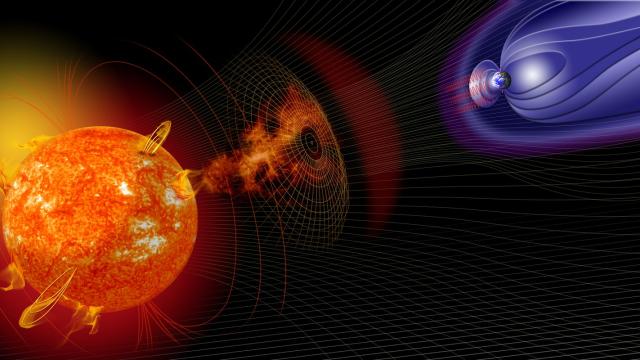The idea that a huge solar storm could wreak havoc here on Earth isn’t just a sci-fi plot, it’s a situation that countries and power grids around the world actively prepare for. But the Trump administration’s latest 2017 budget proposal would completely eliminate the program that keeps the continental US under 24/7 protection from this potentially catastrophic event.
Image: Goddard Space Center, NASA
The Denver-based United States Geological Survey Geomagnetism Program is tasked with monitoring charged particles which are emitted by the Sun as a normal process of solar flares or magnetic storms — sometimes referred to as “space weather”. This data collection is important for industries such as power grids — an electrical surge could have disastrous effects on the power supply — and for oil extraction, as the magnetic properties of the planet can help with aiming the actual drilling. The measurements are also used by the US Department of Defence to keep on eye on their GPS satellites and radio communications around the world.
“Space weather above our heads interacts with the electrically conducting solid Earth beneath our feet to affect infrastructure at the surface of the Earth,” Jeffrey Love, USGS Adviser for Geomagnetic Research at the USGS Geomagnetism Program, told Gizmodo. Since the Earth’s crust (with its constituent rocks and minerals) is a pretty good conductor of electricity, we have to worry about the basic principle of induction during strong electrical events. Induction is the effect of moving magnetic fields interacting with conducting materials to create an electrical current. It’s the same effect that drives electrical motors and wireless chargers. When hit by a solar storm, basically, the planet gets charged up.
Love’s team has learned that the entire $US1.9 million ($2.5 million) program would be eliminated next spring should Trump’s budget proposal become reality. The group operates 14 magnetometer observatories across the US, has 12 full-time employees, and provides real-time data on the Earth’s shifting electrical fields.
“Under normal circumstances there’s very little of this induction going on inside the Earth,” said Love. This all changes during a strong bout of space weather. The power grid’s electrical systems — which use the Earth as a current-dispelling ground — are vulnerable to changes in the Earth’s electrical charge. Grounds act as a sink for the power, and if there’s nowhere for that energy to go, the entire grid overloads and shuts down.
This happens during a large solar storm, like the one that just missed us in 2012, as the magnetically charged particles flow over and through the planet, creating that induction in the Earth’s crust. Worst case scenario would be the major failure of whatever electric infrastructure is facing the storm. It would be gorgeous though, since the largest solar storm on record in 1859 caused an aurora as far south as Cuba.
This isn’t simply theoretical: In 1989, a strong solar storm event known as the Quebec Geomagnetic Blackout completely took out the power in less than two minutes. Today — with our global reliance on our digital communication mediums — those effects would be amplified without the work done by the Geomagnetism Group. They work with the NOAA and NASA to provide info for space weather prediction services.
“Intense storms can last for days, and so it is important to monitor their development,” said Love about the role the Geomagnetism Program plays when the United States is hit by space weather. “In addition, long time series of ground magnetometer data inform scientists of the occurrence frequency and intensity of past magnetic storms.” This data is used to forecast future storms and how bad they can be.
But that’s not all the Geomagnetic Program does.
“[The collected data is] used by the military for diagnosing the reliability of radio communication for the accuracy of GPS systems during magnetic storms, that’s interesting for the Defence Department,” said Love. “Ideally, we should have even more observatories.”
When the program learned of its potential fate, the reaction from industry was swift.
“I have heard from a number of different customers and partners. In general, they are all surprised and concerned at the news of the possibility of the program being eliminated,” said Carol Finn, Group Leader at the Geomagnetism Program.
Love understands that they’re not the only scientific program being cut, but there are continual observations — some of which have been performed for over a century — at risk of being interrupted. This isn’t something where other countries can step in either, as observations are made with localised data that can only be collected nearby to the magnetometers.
“There are other magnetometer systems around the United States, but they are not operated with the degree of reliability that the USGS commits to the operation of its observatories and they are not usually real time,” said Love.
The details have yet to be finalised as Congress still needs to take the next steps and include the cuts in their version of the 2017 US budget, but the fact remains that a really integral scientific program is on the chopping block.
“Our program is a very small program in the United States government, and a very small program in the USGS, but we do provide an important service for the nation and even for the world,” said Love at the end of our conversation. “I think that our program is tax dollars well spent.”
